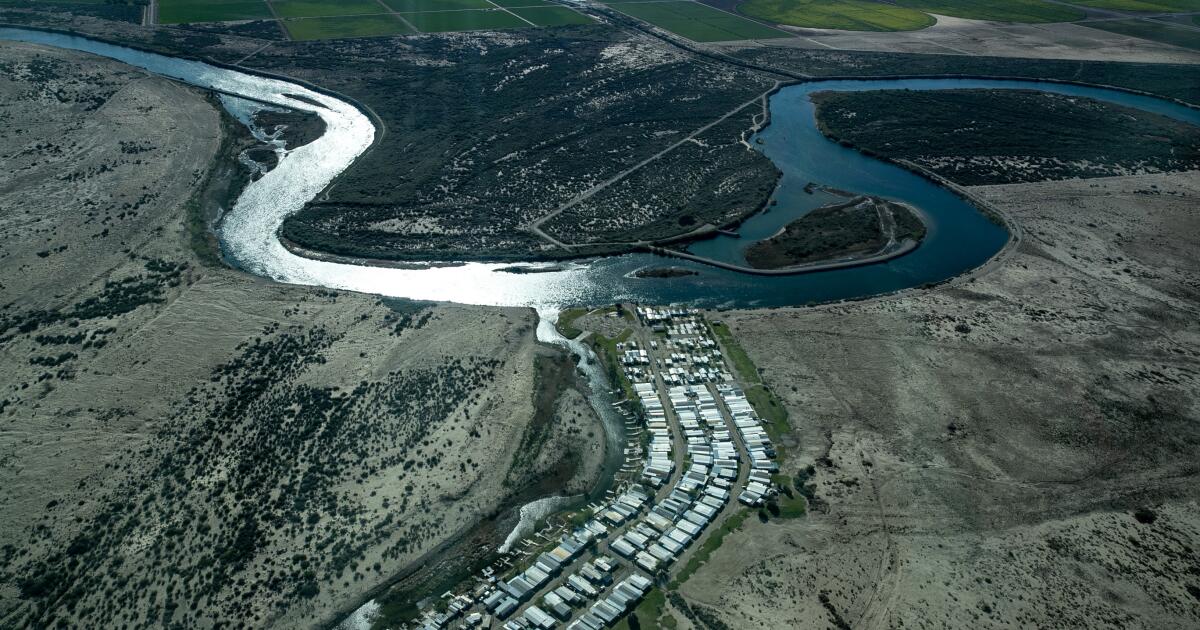Negotiators for seven Western states said they are making progress in ongoing talks over how to share the diminishing waters of the Colorado River, but they provided no specifics. A deadline set by the Trump administration came and went Tuesday without any region-wide agreement on water cutbacks.
The Trump administration gave the states’ negotiators a Nov. 11 deadline to come up with initial terms of a plan to prevent the river’s giant reservoirs from declining to dangerously low levels.
Negotiators for the states and the federal Interior Department said in a joint statement that they “recognize the serious and ongoing challenges facing the Colorado River,” and that “prolonged drought and low reservoir conditions have placed extraordinary pressure on this critical water resource.”
“While more work needs to be done, collective progress has been made that warrants continued efforts to define and approve details for a finalized agreement,” they said.
The talks were held Monday and Tuesday at an undisclosed location. Participants in the negotiations said they plan additional talks in the coming weeks.
The Colorado River provides water to about 35 million people in cities from Denver to San Diego, 30 Native tribes and farming communities from the Rocky Mountains to northern Mexico. It has long been overused, with so much water taken out that for decades the river has seldom met the sea, transforming once-vast wetlands in Mexico into stretches of dry sand.
Over the last quarter of a century, extremely dry conditions have shrunk the river’s flow about 20%, and its giant reservoirs have declined dramatically. Research has shown that global warming, driven largely by the use of fossil fuels, has intensified the long stretch of mostly dry years.
Lake Mead, the river’s largest reservoir, is now just 31% full. And Lake Powell, the river’s second-largest reservoir, is at 29% of capacity.
Persistent disagreements have pitted the three states of the river’s lower basin — California, Arizona and Nevada — against the four upper-basin states — Colorado, Utah, Wyoming and New Mexico. They disagree on how to allot necessary water cuts and other issues, including how much water should be released downstream from Lake Powell on the Utah-Arizona border.
California, Arizona and Nevada put forth a “serious proposal committing to reduce consumption significantly through deep, permanent cuts,” Rep. Greg Stanton (D-Arizona) said. “But our upstream neighbors continue clinging to century-old legal positions that ignore today’s reality. Any proposal that doesn’t require every basin state to share in conservation is pure fantasy.”
The Trump administration, through the Interior Department and the U.S. Bureau of Reclamation, operates the giant dams along the river.
In a statement, Stanton noted that the Trump administration in September withdrew its nomination of Ted Cooke, a former Arizona water manager, to lead the Bureau of Reclamation, because of objections from the upper-basin states. He said that although President Trump still has not put forward a new nominee, “we are running out of time.”
Becky Mitchell, the lead negotiator for Colorado, said in an email that the states are “committed to collaboration.” She did not give details.
Some participants in the talks have said that the disagreements could lead to lawsuits, but that they hope to avoid a legal battle with an uncertain outcome.
Democratic Sen. John Hickenlooper of Colorado called for continued efforts to reach a consensus.
“The only real path to managing the long-term aridification of the West is a seven-state agreement,” Hickenlooper said. “Taking this to court would waste precious resources and could hurt everyone.”
Jennifer Pitt, director of the National Audubon Society’s Colorado River program, said the states’ representatives are in effect saying “they’re committed to continuing to work together, but they don’t have anything yet.”
“I find that concerning,” Pitt said. “It’s been two years, and there’s no agreement yet, but time marches on, and conditions on the river continue to be problematic — more problematic over time as those reservoirs decline.”
The river’s water was originally divided among the states in 1922 under an agreement called the Colorado River Compact, which overpromised what the river could provide.
Pitt said it sometimes seems state officials are clinging to old concepts in that pact or other provisions of the law to prove they are right.
“We have a different river today,” she said. “And we urgently need to take care of it, and take care of the water supply for everyone and everything that depends on it.”
This story originally appeared on LA Times

